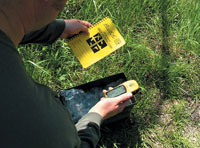- Details
- Written by: David
The heart of Geocaching is its website: geocaching.com, where budding Geocachers can log on, search for a cache nearby and note down its coordinates. There are more than 530,000 caches around the world. These are hidden by other Geocachers and are generally small boxes with a logbook and a selection of souvenirs. ‘It’s all about the excitement of finding the destination, rather than the goodies hidden in the Tupperware box,’ says a first-time geocacher, ‘it makes going for a ramble more interesting, sometimes you also have to solve clues to reach the final target.’
Garmin has taken geocaching a step further and produced a funky new GPS in conjunction with eTrex products that has a ‘Go Geo-Caching’ feature, which simplifies downloading geocaches to Garmin devices. This eliminates entering latitude and longitude or grid reference coordinates manually. To get the new device log onto https://my.garmin.com
Geocaching is a high-tech treasure hunt, encouraging children around the world to lay down their games consoles and join in a worldwide game of hide and seek. It is powered by GPS technology using signals from 27 earth-orbiting satellites to track ‘caches’ (hidden items) around the world using their coordinates.
Thanks to an ever-growing number of easy-to-use and reasonably-priced handheld GPS units, Geocaching is increasingly accessible to all. Once you have the coordinates, all you have to do is enter them into your own GPS and follow the trail to your bounty!
The journey to your cache can be anything from a gentle stroll to an ambitious hike, and every cache comes with a distance, difficulty rating and some detail on the type of terrain you’ll have to cover. Once you’ve found your cache, you can write your name in the logbook, delve into the box of goodies and, provided you leave a souvenir of your own, take something away with you.

 The Buzz
The Buzz

